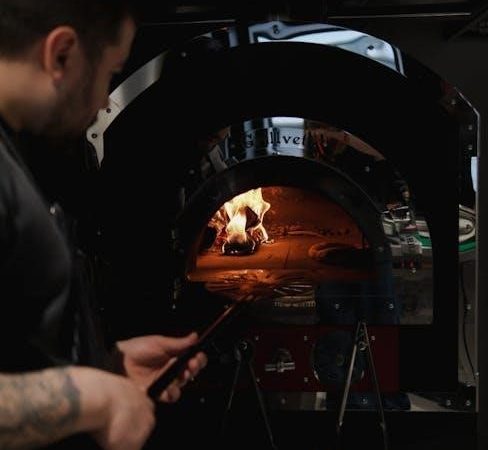Welcome to the Intex Pool Pump Owner’s Manual! This guide provides essential information for safe and effective use of your pool pump, ensuring optimal performance and longevity. Read carefully to understand setup, operation, and maintenance procedures for your Intex pool pump.
Overview of the Manual’s Purpose and Importance
This manual is designed to guide you through the safe and effective use of your Intex pool pump, ensuring optimal performance and longevity. It provides detailed instructions for installation, operation, and maintenance, helping you keep your pool clean and safe for your family. The manual also highlights essential safety precautions to prevent accidents and electrical hazards. By following the guidelines, you can extend the life of your pool and pump while enjoying a hassle-free swimming experience. Additionally, this manual serves as a reference for troubleshooting common issues, ensuring you can address problems promptly. Refer to this manual regularly to maximize your Intex pool pump’s efficiency and reliability.
Key Features of the Intex Pool Pump
The Intex pool pump is designed with innovative features to ensure efficient and reliable performance. It includes a powerful cartridge filter with thicker, heavier paper and more pleats for better filtration. The pump also features water inlet jets for enhanced water flow back into the pool, ensuring cleaner and clearer water. Additionally, it comes with a 2-year warranty for added peace of mind. The pump is equipped with a GFCI (Ground Fault Circuit Interrupter) for electrical safety and includes a built-in timer for convenient operation. Models like the Krystal Clear series offer advanced sand filter technology, providing superior filtration and durability. These features make the Intex pool pump a practical and efficient choice for maintaining your pool.

Safety Precautions and Warnings
Ensure electrical safety by using only properly grounded outlets. Inspect the cord before use and avoid operating if damaged. Keep the pump away from children to prevent accidents. Never use a Portable Residual Current Device (PRCD) with this pump. Follow all safety guidelines to ensure safe operation and longevity of the pump.
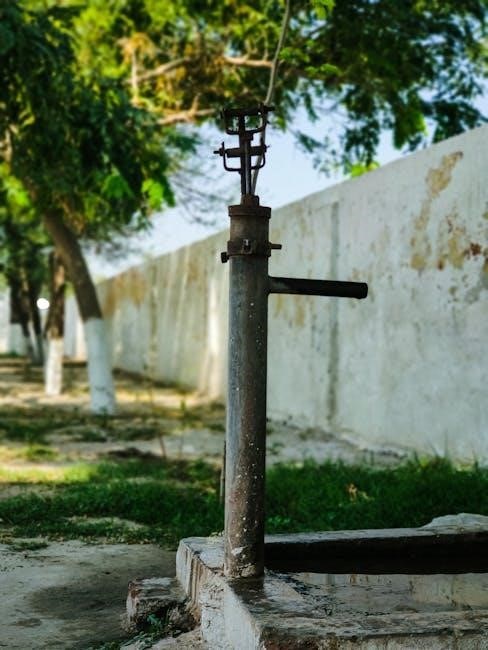
General Safety Guidelines for Pool Pump Usage
Always read and follow the owner’s manual carefully before using the Intex pool pump. Ensure the pump is placed on a stable, level surface away from children. Keep the area around the pump clear of debris and flammable materials. Avoid exposing the pump to extreme weather conditions. Regularly inspect the power cord and connections for damage or wear. Never operate the pump if the cord is damaged. Ensure proper grounding of electrical components to prevent electrocution. Always supervise children when the pump is in operation. Follow all safety warnings and guidelines to ensure safe and efficient use of your Intex pool pump.
Electrical Safety Considerations
Ensure the Intex pool pump is connected to a properly grounded electrical outlet to prevent electrocution. Never use a damaged or frayed power cord, as this can cause electrical hazards. Keep the pump and its components away from water when not in use to avoid accidental activation. Do not submerge the pump in water or expose it to rain. Always turn off the pump and unplug it before performing maintenance or cleaning. Use a Ground Fault Circuit Interrupter (GFCI) protected outlet for added safety. Avoid using extension cords, as they may not provide stable power. Follow all electrical safety guidelines to ensure safe and reliable operation of your Intex pool pump.
Preventing Accidents and Ensuring Safe Operation
To prevent accidents, ensure the Intex pool pump and filter are placed out of children’s reach to avoid unauthorized access or tampering. Always secure the pump and filter on a stable, level surface to prevent tipping. Keep the area around the pump clear of debris and obstacles to maintain proper airflow and function. Regularly inspect hoses and connections for signs of wear or damage, and replace them immediately if necessary. Avoid overloading the pump beyond its recommended capacity, as this can lead to malfunction or damage. Always supervise children when the pump is in operation and ensure the pool area is safe and well-maintained.

Installation and Setup Instructions
Proper installation ensures safe and efficient operation. Assemble the pool first, then position the pump and filter according to the manual. Ensure the area is level and secure all connections tightly, especially hoses, to avoid leaks. Always follow the manufacturer’s guidelines for setup to prevent damage and ensure optimal performance.
Preparation for Installation
Before installing your Intex pool pump, ensure the area is clear and level. Locate the pump at least 10 feet away from the pool to prevent accidental access by children. Gather all necessary tools, such as a screwdriver and pliers, and unpack the pump and accessories. Read the manual thoroughly to understand the setup process. Ensure the pump and filter are placed on a stable, level surface to prevent vibration and uneven water flow. Check for any damage or missing parts before proceeding. Familiarize yourself with the components, including hoses, connections, and valves. Proper preparation ensures a smooth and safe installation process.
Step-by-Step Guide to Assembling the Pump
Begin by unpacking the pump and verifying all components are included. Start by attaching the plunger valve to the pool inlet using the provided adapter. Next, secure the air jet valve to the pump inlet, ensuring it is tightly fastened. Connect the hoses to the designated ports, making sure they are properly aligned and free from kinks. Attach the filter cartridge to the pump housing, following the manufacturer’s alignment guide. Tighten all connections firmly but avoid over-tightening. Finally, double-check all connections for leaks and ensure the pump is placed on a stable, level surface. This step-by-step process ensures your Intex pool pump is assembled correctly and ready for safe operation.
Connecting the Pump to the Pool
Connecting the Intex pool pump to your pool involves attaching the hoses to the correct ports. Ensure the air jet valve is securely tightened to the pool inlet adapter. Align the hose connections properly, making sure they are not kinked or twisted. Tighten all connections firmly to prevent leaks. Once connected, turn on the pump and check for any signs of leakage around the joints. Properly securing the hoses ensures efficient water flow and prevents damage to the pump. Always follow the manufacturer’s guidelines for connection to guarantee safe and effective operation of your Intex pool pump.
Placing the Pump and Filter
Position the Intex pool pump and filter on a level surface to ensure even operation and prevent vibration. Place them a few feet away from the pool to avoid over-stretching the hoses, which can restrict water flow. Choose a well-ventilated area to prevent overheating and moisture buildup. Avoid direct sunlight to protect the pump from excessive heat. Secure the pump on a level surface using provided hardware to prevent tipping. Ensure the pump and filter are accessible for maintenance and located near a properly grounded outlet for electrical safety. Check local building codes for any specific requirements. Proper placement ensures efficient operation, safety, and longevity of the equipment.
Securing the Hose Connections
Securing the hose connections properly is crucial for optimal performance and to prevent leaks. Tighten all hose connections firmly by hand or with a wrench, ensuring they are not over-tightened, which could damage the threads. Use the provided hose clamps or adapters to secure connections between the pump, filter, and pool. For Intex pools with 1-1/4″ (32mm) connections, ensure the air jet valve is securely tightened onto the pool inlet air adaptor and positioned upright. Double-check all connections before starting the pump to avoid water loss and maintain proper water flow. Regularly inspect hoses for signs of wear or damage and replace them if necessary. Properly secured connections ensure efficient operation and prolong the lifespan of your pool pump system.
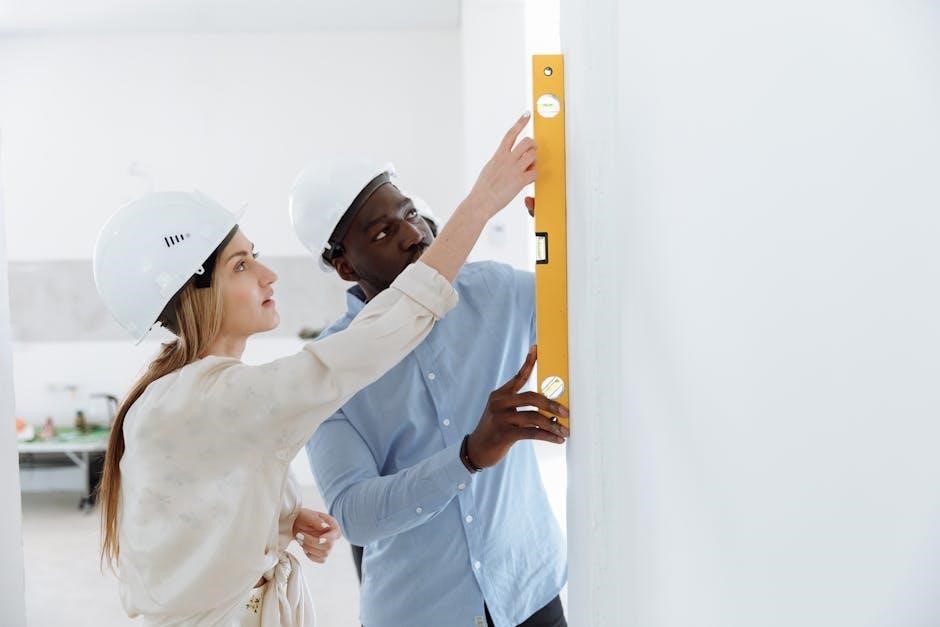
Operating the Intex Pool Pump
Start and stop the pump using the controls, and utilize the timer for efficient operation. Monitor the pump’s performance regularly to ensure smooth and consistent water circulation.

Understanding the Pump’s Controls and Settings
Familiarize yourself with the pump’s control panel, featuring a power switch and timer. The timer allows you to set specific operating times for efficient energy use. Ensure the pump is connected to a GFCI-protected outlet for safety. Adjust the valve settings to regulate water flow direction and pressure. Properly aligning the hoses and connections ensures optimal performance. Refer to the manual for detailed instructions on customizing settings to suit your pool’s needs. Regularly check and maintain the controls to prevent malfunctions and ensure smooth operation.
Starting and Stopping the Pump
To start the pump, ensure all connections are secure and the filter is clean. Plug the pump into a GFCI-protected outlet and flip the power switch. For models with a timer, set the desired operating time. Allow the pump to run until the water is clear. To stop, turn off the power and unplug if not in use. Regular on/off cycles help maintain efficiency. Always follow the manual’s guidelines for safe operation. Caution: Do not use a portable residual current device (RCD). Proper starting and stopping ensures longevity and prevents damage to the pump and pool system.
Using the Timer Function Effectively
The timer function on your Intex pool pump allows for automated operation, optimizing water circulation and energy use. Set the timer according to your pool’s needs, typically 8-12 hours daily, ensuring consistent filtration; This feature prevents overuse and reduces manual intervention. For models with advanced settings, program the pump to run during off-peak hours to save energy. Regularly review and adjust the timer to match seasonal usage or weather changes. Proper use of the timer enhances pump efficiency and maintains clean water year-round. Always refer to the manual for specific timer instructions to maximize its benefits and ensure optimal performance.
Monitoring Pump Performance
Regularly monitoring your Intex pool pump ensures efficient operation and prolongs its lifespan. Check the pump’s sound and vibration; unusual noises may indicate imbalances or blockages. Inspect the filter cartridge frequently to ensure it’s clean and functioning properly. Monitor the water flow rate and pressure gauge to confirm they’re within recommended levels. Look for signs of wear or leaks in hoses and connections. Adjust settings as needed to maintain optimal performance. Keep track of the pump’s operating hours to avoid overuse. By closely monitoring these factors, you can address issues early, preventing potential damage and ensuring your pool remains clean and safe for use.

Maintenance and Cleaning
Regular maintenance ensures your Intex pool pump operates efficiently. Clean the filter cartridge, inspect hoses for leaks, and lubricate moving parts to prevent wear and tear.
Regular Maintenance Tasks
Regular maintenance is crucial for the optimal performance and longevity of your Intex pool pump. Begin by cleaning the filter cartridge weekly, ensuring it’s free from debris. Inspect hoses and connections for leaks or damage, and tighten any loose fittings. Lubricate moving parts, such as O-rings and gaskets, to prevent wear and tear. Additionally, check the pump’s electrical components for proper function and ensure the timer is set correctly. For seasonal maintenance, winterize the pump by draining all water and storing it in a dry, protected area. Follow these tasks to keep your pool pump running efficiently and your pool water clean and safe year-round.
Cleaning the Filter Cartridge
To maintain your Intex pool pump’s efficiency, regularly clean the filter cartridge. Start by turning off the pump and unplugging it for safety. Locate the filter cartridge, typically inside the pump housing, and release any clamps or latches securing it. Gently pull out the cartridge and rinse it with a garden hose to remove debris, being careful not to damage the pleats. For tough dirt, soak the cartridge in a mixture of water and vinegar for about an hour. Avoid using a pressure washer to prevent damage. After cleaning, allow the cartridge to air dry to prevent mold growth. Reinstall it securely and ensure all connections are tight. Regular cleaning every week or two will keep your pump running smoothly and your pool water clean.
Replacing the Filter Cartridge
To replace the filter cartridge in your Intex pool pump, start by turning off the pump and unplugging it for safety. Open the pump housing by releasing the clamps or latches. Carefully remove the old cartridge, taking note of its position for proper installation of the new one. Inspect the housing and rinse it to remove any debris. Insert the new cartridge, ensuring it is securely seated and aligned correctly. Close the housing and reattach it using the clamps or latches. Dispose of the old cartridge properly. Plug in the pump and turn it on to test its operation. For optimal performance, replace the cartridge every one to two seasons, depending on usage. Always use the correct replacement cartridge for your specific model to maintain effective filtration and prevent damage to the pump. Keep track of replacement dates to stay organized and ensure consistent pool maintenance.
Winterizing the Pump
Winterizing your Intex pool pump is essential to protect it from freezing temperatures and ensure optimal performance in the next season. Start by turning off the pump and unplugging it from the power source. Drain all water from the pump and connected hoses to prevent ice damage. Disconnect the hoses and clean the pump housing thoroughly. Remove and clean or replace the filter cartridge as needed. Store the pump, hoses, and filter in a dry, protected area, such as a shed or garage, away from direct sunlight and moisture. Before storing, ensure all components are completely dry to prevent mold or mildew growth. For detailed instructions, refer to your specific model’s manual. Proper winterization will extend the pump’s lifespan and ensure it operates efficiently when you reopen your pool.
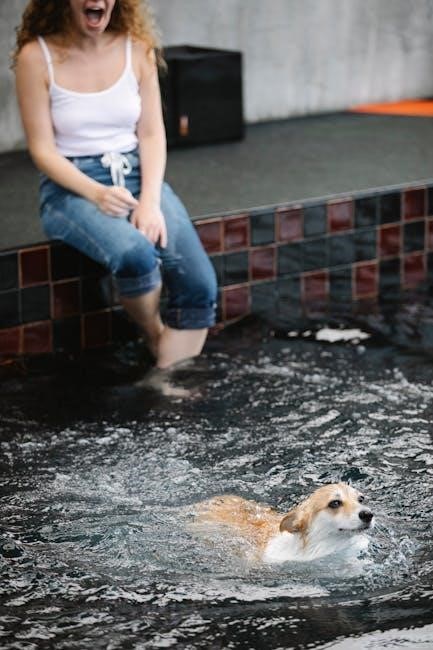
Troubleshooting Common Issues
Identify symptoms like low water flow or pump failure. Check for blockages, ensure proper connections, and clean filters. Consult the manual for specific solutions to restore functionality.
Identifying and Diagnosing Problems
Start by observing the pump’s behavior and performance. Common issues include low water flow, excessive noise, or the pump not turning on. Check for blockages in hoses or filters, as these often cause reduced flow. Ensure all connections are secure and properly aligned. If the pump fails to start, verify that it is correctly plugged into a grounded outlet and that the electrical cord is undamaged. Clean or replace the filter cartridge if dirty, as this can restrict water flow. For noise issues, inspect the pump housing for loose parts or debris. Refer to the manual for specific troubleshooting guides and solutions to restore optimal functionality.
Resolving Common Errors
Addressing issues promptly ensures your Intex pool pump operates efficiently; If the pump has low water flow, clean or replace the filter cartridge and check for kinked or blocked hoses. For excessive noise, ensure all connections are tight and debris-free. If the pump doesn’t start, verify the electrical connection and reset the GFCI if necessary. For persistent problems, consult the troubleshooting section in your manual. Always turn off the pump before attempting repairs. Regular maintenance, such as cleaning the strainer basket, can prevent many issues. Refer to the specific error codes or symptoms in your manual for tailored solutions to restore functionality quickly and safely.
Adjusting and Repairing Pump Components
Maintaining your Intex pool pump involves periodic adjustments and repairs to ensure optimal performance. Start by inspecting the filter cartridge and cleaning or replacing it as needed. Check the strainer basket for debris and rinse it thoroughly. If hoses are loose, tighten connections with a wrench. For faulty valves, replace the O-rings or gaskets. If the pump vibrates excessively, level the base or secure it firmly. Always turn off the pump before making adjustments. For complex issues, consult the manual or contact Intex support. Regular maintenance can prevent major repairs and extend the pump’s lifespan. Keep replacement parts on hand for quick fixes.
Proper maintenance and regular inspections ensure your Intex pool pump operates efficiently. Follow guidelines for optimal performance and a safe, enjoyable pool experience.

Best Practices for Long-Term Use
For long-term efficiency, always follow the manufacturer’s guidelines. Regularly clean the filter cartridge and ensure proper hose connections to prevent leaks. Store the pump in a dry, cool place during off-seasons to avoid damage. Replace worn-out parts promptly and maintain the recommended water flow rate. Avoid overloading the pump, as this can reduce its lifespan. By adhering to these practices, you’ll ensure your Intex pool pump continues to deliver optimal performance and keep your pool water clean and safe for years to come.
Ensuring Optimal Performance
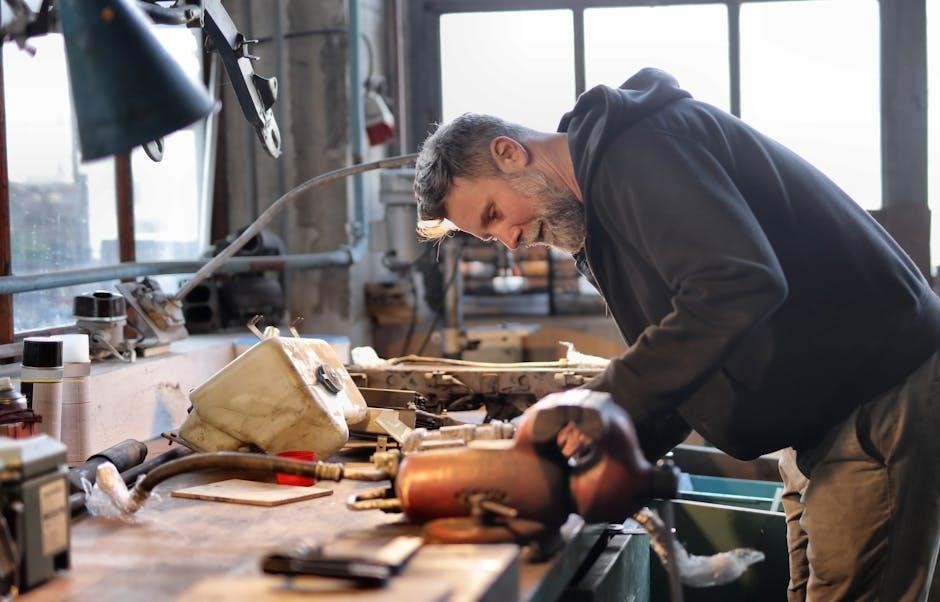
To ensure your Intex pool pump operates at its best, perform regular maintenance and monitor its performance. Clean the filter cartridge frequently to prevent clogs and maintain water flow. Check hose connections for tightness to avoid leaks and ensure proper water circulation. Place the pump on a level surface to prevent vibration and noise. Use the timer function wisely to balance filtration needs with energy efficiency. Additionally, monitor the pump’s flow rate and adjust as necessary to maintain clear and clean water. By following these steps, you can maximize the pump’s efficiency and extend its lifespan, keeping your pool water sparkling and safe for enjoyment.
